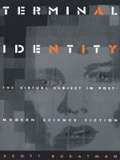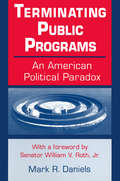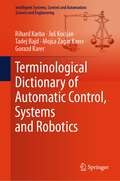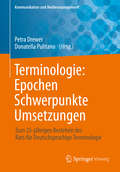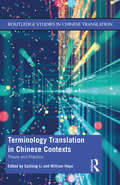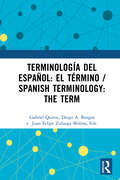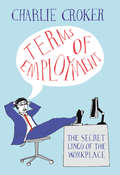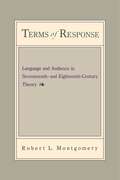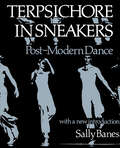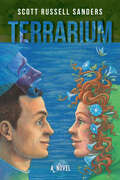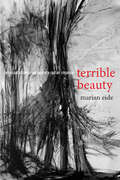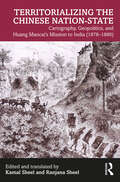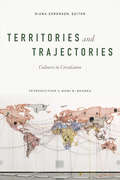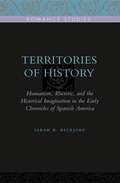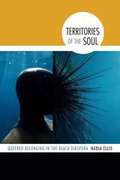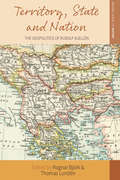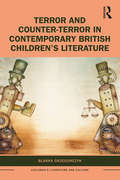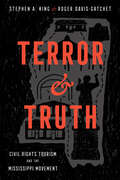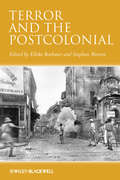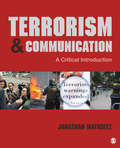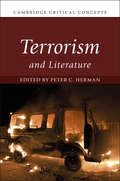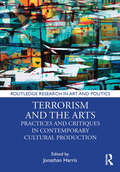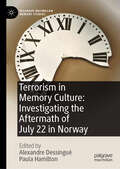- Table View
- List View
Term Rewriting and All That
by Franz Baader Tobias NipkowThis textbook offers a unified, self-contained introduction to the field of term rewriting. Baader and Nipkow cover all the basic material--abstract reduction systems, termination, confluence, completion, and combination problems--but also some important and closely connected subjects: universal algebra, unification theory, Gröbner bases, and Buchberger's algorithm. They present the main algorithms both informally and as programs in the functional language Standard ML (An appendix contains a quick and easy introduction to ML). Key chapters cover crucial algorithms such as unification and congruence closure in more depth and develop efficient Pascal programs. The book contains many examples and over 170 exercises. This is also an ideal reference book for professional researchers: results spread over many conference and journal articles are collected here in a unified notation, detailed proofs of almost all theorems are provided, and each chapter closes with a guide to the literature.
Terminal Identity: The Virtual Subject in Postmodern Science Fiction
by Scott BukatmanScott Bukatman's Terminal Identity--referring to both the site of the termination of the conventional "subject" and the birth of a new subjectivity constructed at the computer terminal or television screen--puts to rest any lingering doubts of the significance of science fiction in contemporary cultural studies. Demonstrating a comprehensive knowledge, both of the history of science fiction narrative from its earliest origins, and of cultural theory and philosophy, Bukatman redefines the nature of human identity in the Information Age. Drawing on a wide range of contemporary theories of the postmodern--including Fredric Jameson, Donna Haraway, and Jean Baudrillard--Bukatman begins with the proposition that Western culture is suffering a crisis brought on by advanced electronic technologies. Then in a series of chapters richly supported by analyses of literary texts, visual arts, film, video, television, comics, computer games, and graphics, Bukatman takes the reader on an odyssey that traces the postmodern subject from its current crisis, through its close encounters with technology, and finally to new self-recognition. This new "virtual subject," as Bukatman defines it, situates the human and the technological as coexistent, codependent, and mutally defining.Synthesizing the most provocative theories of postmodern culture with a truly encyclopedic treatment of the relevant media, this volume sets a new standard in the study of science fiction--a category that itself may be redefined in light of this work. Bukatman not only offers the most detailed map to date of the intellectual terrain of postmodern technology studies--he arrives at new frontiers, providing a propitious launching point for further inquiries into the relationship of electronic technology and culture.
Terminating Public Programs: An American Political Paradox
by Mark R. DanielsThis text examines why and when policies or organizations are terminated, how they can be terminated successfully, and what often prevents them from being terminated. The literature on termination and a variety of case studies are reviewed in order to identify theories supported by research.
Terminological Dictionary of Automatic Control, Systems and Robotics (Intelligent Systems, Control and Automation: Science and Engineering #104)
by Tadej Bajd Juš Kocijan Gorazd Karer Rihard Karba Mojca Žagar KarerThis dictionary contains terms from the fields of automatic control, which includes mathematical modelling, simulation of dynamic systems, automation technology with its corresponding elements, and robotics. It also includes signal processing, information technologies and production technologies.The terminological dictionary is primarily aimed at experts and students who deal with control technology and dynamic systems in both technical and non-technical domains. To be able to use the dictionary, at least basic knowledge in this field is required. In the dictionary users will find concise terminological definitions. A concept may be designated by different terms; therefore, cross-references are used. The aim of the dictionary is to collect and unify – at least to an achievable extent – the terminology in the field of automatic control, dynamic systems and robotics.
Terminologie: Zum 25-jährigen Bestehen des Rats für Deutschsprachige Terminologie (Kommunikation und Medienmanagement)
by Petra Drewer Donatella PulitanoAlle, die sich mit fachsprachlichen Texten beschäftigen, beschäftigen sich automatisch auch mit Terminologie: Beim Lesen von Fachtexten nehmen sie die darin enthaltene Terminologie auf, beim Verfassen von Fachtexten verwenden oder produzieren sie Terminologie, beim Fachübersetzen übertragen sie Terminologie in andere Sprachen.Im Laufe der Zeit haben sich Methoden und Verfahren entwickelt, wie man professionell und effizient mit Terminologie arbeitet. Die Auseinandersetzung mit den Grundsätzen der Terminologiearbeit hat sich zu einer wissenschaftlichen Disziplin entwickelt.Der Rat für Deutschsprachige Terminologie (RaDT) wurde 1994 als Initiative der UNESCO-Kommissionen Deutschlands, Österreichs und der Schweiz gegründet, um terminologische Aktivitäten zu fördern. Zu seinem 25-jährigen Bestehen erscheint nun dieser Sammelband, der einen Überblick über das vielfältige Schaffen und das gesamte Themenspektrum der RaDT-Mitglieder bietet.Um die verschiedenen Perspektiven innerhalb der RaDT-Gemeinschaft angemessen wiederzugeben, umfasst der Band vier Themenbereiche:1. Vielfalt an Epochen2. Vielfalt an Schwerpunkten3. Vielfalt an Umsetzungen (in öffentlichen Institutionen)4. Vielfalt an Umsetzungen (in der Privatwirtschaft)Dieser Sammelband richtet sich an alle, die sich mit Terminologie, Terminologiewissenschaft oder Terminologiearbeit befassen, insbesondere in Unternehmensbereichen wie Sprachmanagement, Terminologiemanagement, Corporate Language, Wissensmanagement, sowie an Studierende und Wissenschaftler in den entsprechenden Disziplinen.
Terminology Translation in Chinese Contexts: Theory and Practice (Routledge Studies in Chinese Translation)
by William Hope Saihong LiTerminology Translation in Chinese Contexts: Theory and Practice investigates the theory and practice of terminology translation, terminology management, and scholarship within the distinctive milieu of Chinese and explores the complex relationship between terminology translation (micro level) and terminology management (macro level). This book outlines the contemporary challenges of terminology translation and terminology management within Chinese contexts in specialized fields including law, the arts, religion, Chinese medicine, and food products. The volume also examines how the development and application of new technologies such as big data, cloud computing, and artificial intelligence have brought about major changes in the language service industry. Technology such as machine translation and computer-assisted translation has spawned new challenges in terminology management practices and has facilitated their evolution in contexts of ever greater internationalization and globalization. This book recontextualizes terminology translation and terminology management with a special focus on English–Chinese translation. It is hoped that the volume will enable and enhance dialogue between Chinese and Western scholars and professionals in the field. All chapters have been written by specialists in the different subfields and have been peer-reviewed by the editors.
Terminología del español: el término / Spanish Terminology: The Term
by Gabriel Quiroz Diego A. Burgos Juan Felipe Zuluaga MolinaTerminología del español: el término / Spanish Terminology: The Term provides a consolidated and research-based guide to Terminology Science in Spanish. This edited collection brings together experts in the field who draw upon a large-scale, multi-subject terminology and corpus linguistics research project to provide data, examples, trends, models, analysis, and discussion of terms.Readers will find this a practical guide to term characterization that can be applied to tasks and processes related to terminology, term extraction, specialized translation, knowledge representation, and language for specific purposes. Nine of the 13 chapters focus on a specialized category ranging from terminological nouns and verbs to complex terms and specialized phraseology and offers a qualitative characterization of the relevant category, as well as a quantitative insight into the category trends in a representative corpus of specialized discourses in Spanish. The volume also includes chapters on the teaching of terminology, term extraction, the methodology of terminological projects, and a quantum theory of the term.This volume will be of interest to specialists in Terminology, Spanish linguistics, technology-mediated language processing, specialized translation, specialized lexicography, and language for specific purposes.Terminología del español: el término / Spanish Terminology: The Term constituye una guía comprensiva y basada en investigación sobre la Terminología en español. Este volumen editado reúne a expertos en el campo, los cuales se basan en un proyecto de investigación multidisciplinario y representativo en terminología y lingüística de corpus para mostrar datos, ejemplos, tendencias, modelos, análisis y discusión de diversos términos.Los lectores encontrarán en este libro una guía práctica para la caracterización de términos, lo cual se puede aplicar a tareas y procesos relacionados con la terminología, la extracción de términos, la traducción especializada, la representación del conocimiento y el lenguaje con fines específicos, entre otros. Nueve de los 13 capítulos se centran en una categoría especializada que va desde sustantivos y verbos terminológicos hasta términos complejos y fraseología especializada, y ofrecen una caracterización cualitativa de la categoría relevante, así como una perspectiva cuantitativa sobre las tendencias de la categoría en un corpus representativo de discursos especializados en español. El volumen también incluye un capítulo que propone una teoría cuántica del término, así como tres capítulos adicionales dedicados a la enseñanza de la terminología, la extracción de términos y la metodología de proyectos terminológicos.El volumen será de interés para especialistas en Terminología, lingüística española, procesamiento del lenguaje mediado por tecnologías, traducción especializada, lexicografía especializada y lenguas con fines específicos.
Terms of Employment: The secret lingo of the workplace
by Charlie CrokerHas your doctor ever prescribed you some bug-juice? Or sent you to the rheumaholiday department?Have you ever read an article full of anecdata or reviewphemisms?Do you think you work in an adhocracy, for a seagull manager?Every workplace has its own words and phrases, from the Smurf juice used to clean plane toilets to the Peckham Rolexes, worn by criminals on release from prison. For Terms of Employment, Charlie Croker has patrolled hospital corridors, hung out by office water-coolers and lingered in shops to listen in on the conversations that only take place at work, gathering together the jargon we all use, often without thinking. Whether you're a white wig (new barrister), a heatseeker (ambitious employee) or an entreprenerd (geeky IT pioneer) Terms of Employment is an invaluable - and entertaining - guide.
Terms of Response: Language and the Audience in Seventeenth- and Eighteenth-Century Theory
by Robert MontgomeryThis book takes a new look at the place occupied by medieval Spanish epic within European folk and literary tradition. Thomas Montgomery traces the origins of key parts of most known medieval Spanish epics to an ancient myth. He shows how the myth of the initiation of the young warrior, shown by Georges Dumézil to be fundamental to the belief systems of widely distributed Indo-European peoples, was variously adapted to shape the action of texts including the Siete Infantes de Lara, the Mocedades de Rodrigo, and the Poema de Mio Cid, in which it accounts for the peculiar behavior of the Infantes de Carrión. Montgomery also connects the same mythic tradition to works as diverse as Tristan and the Chanson de Roland.In a preliterate society, the oral presentation of this archetypal lore required a special language capable of re-creating the ritualized behavior of the epic characters and maintaining the ceremonial tone of the performance. Focusing on the Poema de Mio Cid, Montgomery examines the ways in which the poetic language worked to evoke a feeling of group unity that absorbed the audience and still works its spell upon today’s readers.
Terms of Response: Language and the Audience in Seventeenth- and Eighteenth-Century Theory (G - Reference, Information and Interdisciplinary Subjects)
by Robert MontgomeryThis book takes a new look at the place occupied by medieval Spanish epic within European folk and literary tradition. Thomas Montgomery traces the origins of key parts of most known medieval Spanish epics to an ancient myth. He shows how the myth of the initiation of the young warrior, shown by Georges Dumézil to be fundamental to the belief systems of widely distributed Indo-European peoples, was variously adapted to shape the action of texts including the Siete Infantes de Lara, the Mocedades de Rodrigo, and the Poema de Mio Cid, in which it accounts for the peculiar behavior of the Infantes de Carrión. Montgomery also connects the same mythic tradition to works as diverse as Tristan and the Chanson de Roland.In a preliterate society, the oral presentation of this archetypal lore required a special language capable of re-creating the ritualized behavior of the epic characters and maintaining the ceremonial tone of the performance. Focusing on the Poema de Mio Cid, Montgomery examines the ways in which the poetic language worked to evoke a feeling of group unity that absorbed the audience and still works its spell upon today’s readers.
Terpsichore in Sneakers: Post-Modern Dance
by Sally BanesA dance critic's essays on post-modern dance. Drawing on the postmodern perspective and concerns that informed her groundbreaking Terpischore in Sneakers, Sally Bane's Writing Dancing documents the background and development of avant-garde and popular dance, analyzing individual artists, performances, and entire dance movements. With a sure grasp of shifting cultural dynamics, Banes shows how postmodern dance is integrally connected to other oppositional, often marginalized strands of dance culture, and considers how certain kinds of dance move from the margins to the mainstream. Banes begins by considering the act of dance criticism itself, exploring its modes, methods, and underlying assumptions and examining the work of other critics. She traces the development of contemporary dance from the early work of such influential figures as Merce Cunningham and George Balanchine to such contemporary choreographers as Molissa Fenley, Karole Armitage, and Michael Clark. She analyzes the contributions of the Judson Dance Theatre and the Workers' Dance League, the emergence of Latin postmodern dance in New York, and the impact of black jazz in Russia. In addition, Banes explores such untraditional performance modes as breakdancing and the "drunk dancing" of Fred Astaire.
Terrarium: A Novel
by Scott Russell SandersWith round-the-clock drugs, games, and eros parlors to entertain them and virtual weather to sustain them, humans live inside a global network of domed cities known collectively as "the Enclosure. " Having poisoned the biosphere, we've had to close ourselves off from the Earth. The cities of the Enclosure are scattered around the globe on the land and sea, and are connected by a web of travel tubes, so no one needs to risk exposure. Health Patrollers police the boundaries of the Enclosure to keep the mutants and pollution out. Phoenix Marshall decodes satellite images for a living. He has spent all 30 years of his life in Oregon City, afloat on the Pacific Ocean. He busies himself with work and various forms of recreation to keep boredom at bay. One morning he opens his door to find Teeg Passio. Teeg is the same age as Phoenix, but she's different; she's menacingly and enticingly wild. She grew up on the outside. Her mother oversaw the recycling of the old cities, and her father helped design the Enclosure. Teeg works maintenance, which allows her to travel outside the walls. When she introduces Phoenix to her crew, he is drawn into a high-tech conspiracy that may threaten everything he understands. Are humans really better off within the Enclosure? Is the Earth? Are Health Patrollers keeping us safe or just keeping us in? Teeg seduces Phoenix out of his orderly life, enlisting him in a secret, political and sexual rebellion. Teeg and her co-conspirators, part mystics, part tech-wizards, dream of a life embedded in nature. Then one day, during a closely monitored repair mission on the outside, a typhoon offers the rebels a chance to escape the Enclosure and test their utopian dreams in the wilds.
Terrible Beauty: The Violent Aesthetic and Twentieth-Century Literature (Cultural Frames, Framing Culture)
by Marian EideIf art is our bid to make sense of the senseless, there is hardly more fertile creative ground than that of the twentieth century. From the trench poetry of World War I and Holocaust memoirs by Primo Levi and Elie Wiesel to the post-colonial novels of southern Asia and the anti-apartheid plays of the South African Market Theater, writers have married beauty and horror. This "century of trauma" produced writing at once saturated in political violence and complicated by the ethics of aesthetic representation. Stretching across genres and the globe, Terrible Beauty charts a course of aesthetic reconciliation between empathy and evil in the great literature of the twentieth century.The "violent aesthetic"—a category the author traces back to Plato and Nietzsche—accommodates the pleasure people take not only in destruction itself but also in its rendering. As readers, we oscillate between a fascination with atrocity and an ethical imperative to bear witness. Arguing for the immersive experience of literature as particularly conducive to ethical contemplation, Marian Eide plumbs the aesthetic power and ethical purpose of this creative tension. By invoking the reader as complicit—both stricken witness and enthralled voyeur— Terrible Beauty sheds new light on the relationship between violence, literature, and the moral burdens of art.
Territorializing the Chinese Nation-State: Cartography, Geopolitics, and Huang Maocai's Mission to India (1878–1880)
by Kamal Sheel and Ranjana SheelThis book is the first annotated translation of the travelogues of Huang Maocai. A trained Chinese cartographer in the service of the imperial Qing state, he was officially deputed to ascertain the Tibet–India land route and the geopolitical status of British India in the nineteenth century. His travelogues are the first authoritative modern Chinese texts exploring the physical and ideological connections between China and India. Unpublished for a long time, and so far, unavailable in an English translation, these texts provide meaning to many key issues that enshroud the concepts of civilization and nation.An important contribution to the study of Sino–Indian interactions, it demonstrates Huang Maocai's keen observation of the geopolitics of the region. His vivid descriptions of Kolkata and nearby regions enlighten the Chinese perception of colonial India. This book will be an indispensable resource for students and researchers of nation, nationalism, civilization, empire, frontiers and borders, modern history, translation studies, Chinese studies, and Asian studies.
Territories and Trajectories: Cultures in Circulation
by Homi K. Bhabha Diana SorensenThe contributors to Territories and Trajectories propose a model of cultural production and transmission based on the global diffusion, circulation, and exchange of people, things, and ideas across time and space. This model eschews a static, geographically bounded notion of cultural origins and authenticity, privileging instead a mobility of culture that shapes and is shaped by geographic spaces. Reading a diverse array of texts and objects, from Ethiopian song and ancient Chinese travel writing to Japanese literature and aerial and nautical images of the Indian Ocean, the contributors decenter national borders to examine global flows of culture and the relationship between thinking at transnational and local scales. Throughout, they make a case for methods of inquiry that encourage innovative understandings of borders, oceans, and territories and that transgress disciplinary divides. Contributors. Homi Bhabha, Jacqueline Bhabha, Lindsay Bremner, Finbarr Barry Flood, Rosario Hubert, Alina Payne, Kay Kaufman Shelemay, Shu-mei Shih, Diana Sorensen, Karen Thornber, Xiaofei Tian
Territories of History: Humanism, Rhetoric, and the Historical Imagination in the Early Chronicles of Spanish America (Penn State Romance Studies #2)
by Sarah H. BeckjordSarah H. Beckjord’s Territories of History explores the vigorous but largely unacknowledged spirit of reflection, debate, and experimentation present in foundational Spanish American writing. In historical works by writers such as Gonzalo Fernández de Oviedo, Bartolomé de Las Casas, and Bernal Díaz del Castillo, Beckjord argues, the authors were not only informed by the spirit of inquiry present in the humanist tradition but also drew heavily from their encounters with New World peoples. More specifically, their attempts to distinguish superstition and magic from science and religion in the New World significantly influenced the aforementioned chroniclers, who increasingly directed their insights away from the description of native peoples and toward a reflection on the nature of truth, rhetoric, and fiction in writing history.Due to a convergence of often contradictory information from a variety of sources—eyewitness accounts, historiography, imaginative literature, as well as broader philosophical and theological influences—categorizing historical texts from this period poses no easy task, but Beckjord sifts through the information in an effective, logical manner. At the heart of Beckjord’s study, though, is a fundamental philosophical problem: the slippery nature of truth—especially when dictated by stories. Territories of History engages both a body of emerging scholarship on early modern epistemology and empiricism and recent developments in narrative theory to illuminate the importance of these colonial authors’ critical insights. In highlighting the parallels between the sixteenth-century debates and poststructuralist approaches to the study of history, Beckjord uncovers an important legacy of the Hispanic intellectual tradition and updates the study of colonial historiography in view of recent discussions of narrative theory.
Territories of the Soul: Queered Belonging in the Black Diaspora
by Nadia EllisNadia Ellis attends to African diasporic belonging as it comes into being through black expressive culture. Living in the diaspora, Ellis asserts, means existing between claims to land and imaginative flights unmoored from the earth--that is, to live within the territories of the soul. Drawing on the work of Jose Muñoz, Ellis connects queerness' utopian potential with diasporic aesthetics. Occupying the territory of the soul, being neither here nor there, creates in diasporic subjects feelings of loss, desire, and a sensation of a pull from elsewhere. Ellis locates these phenomena in the works of C.L.R. James, the testy encounter between George Lamming and James Baldwin at the 1956 Congress of Negro Artists and Writers in Paris, the elusiveness of the queer diasporic subject in Andrew Salkey's novel Escape to an Autumn Pavement, and the trope of spirit possession in Nathaniel Mackey's writing and Burning Spear's reggae. Ellis' use of queer and affect theory shows how geographies claim diasporic subjects in ways that nationalist or masculinist tropes can never fully capture. Diaspora, Ellis concludes, is best understood as a mode of feeling and belonging, one fundamentally shaped by the experience of loss.
Territory, State and Nation: The Geopolitics of Rudolf Kjellén (Making Sense of History #41)
by Ragnar Björk Thomas LundénRudolf Kjellén, regularly referred to as “the father of geopolitics,” developed in the first decade of the twentieth century an analytical model for calculating the capabilities of great-power states and promoting their interests in the international arena. It was an ambitious intellectual project that sought to bring politics into the sphere of social science. Bringing together experts on Kjellén from across the disciplines, Territory, State and Nation explores the century-long international impact, analytical model, and historical theories of a figure immensely influential in his time who is curiously little-known today.
Terror and Counter-Terror in Contemporary British Children’s Literature (Children's Literature and Culture)
by Blanka GrzegorczykThe widespread threat of terrorist and counter-terrorist violence in the twenty-first century has created a globalized context for social interactions, transforming the ways in which young people relate to the world around them and to one another. This is the first study that reads post-9/11 and 7/7 British writing for the young as a response to this contemporary predicament, exploring how children’s writers find the means to express the local conditions and different facets of the global wars around terror. The texts examined in this book reveal a preoccupation with overcoming various forms of violence and prejudice faced by certain groups within post-terror Britain, as well as a concern with mapping out their social relations with other groups, and those concerns are set against the recurring themes of racist paranoia, anti-immigrant hostility, politicized identities, and growing up in countries transformed by the effects of terror and counter-terror. The book concentrates on the relationship between postcolonial and critical race studies, Britain’s colonial legacy, and literary representations of terrorism, tracing thematic and formal similarities in the novels of both established and emerging children’s writers such as Elizabeth Laird, Sumia Sukkar, Alan Gibbons, Muhammad Khan, Bali Rai, Nikesh Shukla, Malorie Blackman, Claire McFall, Miriam Halahmy, and Sita Brahmachari. In doing so, this study maps new connections for scholars, students, and readers of contemporary children’s fiction who are interested in how such writing addresses some of the most pressing issues affecting us today, including survival after terror, migration, and community building.
Terror and Truth: Civil Rights Tourism and the Mississippi Movement (Race, Rhetoric, and Media Series)
by Stephen A. King Roger Davis GatchetStephen A. King and Roger Davis Gatchet examine how Mississippi confronts its history of racial violence and injustice through civil rights tourism. Mississippi’s civil rights memorials include a vast constellation of sites and experiences—from the humble Fannie Lou Hamer Museum in Ruleville to the expansive Mississippi Civil Rights Museum in Jackson—where the state’s collective memories of the movement are enshrined, constructed, and contested. Rather than chronicle the history of the Mississippi Movement, the authors explore the museums, monuments, memorials, interpretive centers, homes, and historical markers marketed to heritage tourists in the state. Terror and Truth: Civil Rights Tourism and the Mississippi Movement is the first book to examine critically and unflinchingly Mississippi’s civil rights tourism industry. Combining rhetorical analysis, onsite fieldwork, and interviews with museum directors, local civil rights entrepreneurs, historians, and movement veterans, the authors address important questions of memory and the Mississippi Movement. How is Mississippi, a poor, racially divided state with a long history of systemic racial oppression and white supremacy, actively packaging its civil rights history for tourists? Whose stories are told? And what perspectives are marginalized in telling those stories? The ascendency of civil rights memorialization in Mississippi comes at a time when the nation is reckoning with its racial past, as evidenced by the Black Lives Matter movement, Mississippi’s adoption of a new state flag, the conviction of former members of the Ku Klux Klan, and the removal of Confederate monuments throughout the South. Terror and Truth directly engages this national conversation.
Terror and the Postcolonial: A Concise Companion (Concise Companions to Literature and Culture #40)
by Elleke Boehmer Stephen MortonTerror and the Postcolonial is a major comparative study of terrorism and its representations in postcolonial theory, literature, and culture. A ground-breaking study addressing and theorizing the relationship between postcolonial studies, colonial history, and terrorism through a series of contemporary and historical case studies from various postcolonial contexts Critically analyzes the figuration of terrorism in a variety of postcolonial literary texts from South Asia, Africa, and the Middle East Raises the subject of terror as both an expression of globalization and a postcolonial product Features key essays by well-known theorists, such as Robert J. C. Young, Derek Gregory, and Achille Mbembe, and Vron Ware
Terrorism and Communication: A Critical Introduction
by Jonathan MatusitzBased on the premise that terrorism is essentially a message, Terrorism and Communication: A Critical Introduction examines terrorism from a communication perspective—making it the first text to offer a complete picture of the role of communication in terrorist activity. Through the extensive examination of state-of-the-art research on terrorism as well as recent case studies and speech excerpts, communication and terrorism scholar Jonathan Matusitz explores the ways that terrorists communicate messages through actions and discourse. Using a multifaceted approach, he draws valuable insights from relevant disciplines, including mass communication, political communication, and visual communication, as he illustrates the key role that media outlets play in communicating terrorists′ objectives and examines the role of global communication channels in both spreading and combating terrorism. This is an essential introduction to understanding what terrorism is, how it functions primarily through communication, how we talk about it, and how we prevent it.
Terrorism and Literature (Cambridge Critical Concepts)
by Peter C. HermanTerrorism has long been a major shaping force in the world. However, the meanings of terrorism, as a word and as a set of actions, are intensely contested. This volume explores how literature has dealt with terrorism from the Renaissance to today, inviting the reader to make connections between older instances of terrorism and contemporary ones, and to see how the various literary treatments of terrorism draw on each other. The essays demonstrate that the debates around terrorism only give the fictive imagination more room, and that fiction has a great deal to offer in terms of both understanding terrorism and our responses to it. Written by historians and literary critics, the essays provide essential knowledge to understand terrorism in its full complexity. As befitting a global problem, this book brings together a truly international group of scholars, with representatives from America, Scotland, Canada, New Zealand, Italy, Israel, and other countries.
Terrorism and the Arts: Practices and Critiques in Contemporary Cultural Production (Routledge Research in Art and Politics)
by Jonathan HarrisThis book assesses the key definitions, forms, contexts and impacts of terrorist activity on the arts in the modern era, using historical and contemporary perspectives. Its empirical case studies include theatre, literature, music, visual art, mass media, film and the mores of ‘ordinary life.’ While its immediate reflective context is Islamic fundamentalist terrorism, the book reviews a broader range of definitions and counter-definitions of 'terrorism', 'state terrorism' and 'states of terror,' examining uses of the terms through a series of comparative analyses. Chapters focus on the intersection of these definitional questions with heuristic analysis of art forms, cultural activities and their socio-historical contexts. This book will be of interest to scholars in art history, terrorism, politics and the media, and visual culture.
Terrorism in Memory Culture: Investigating the Aftermath of July 22 in Norway (Palgrave Macmillan Memory Studies)
by Paula Hamilton Alexandre DessinguéThis edited collection examines the intersection between the developing fields of terrorism and cultural memory studies through a detailed study of the 2011 terrorist attack in Norway. It examines how the work of remembrance has been established through arts such as theatre and fiction, and also architecture, heritage and education. It traces the politics of the remembrance processes and explores the shifting meanings in public memories that change over the thirteen years since the attack, and are constantly being negotiated in response to present circumstances. It also charts general trends in memorialisation: the globalising and digitalising of memory practices, the speed of memorial initiatives, the role of testimony, and the importance of diverse narratives emerging through newer modes of communication. Chapters 10, 13 and 16 are available open access under a Creative Commons Attribution 4.0 International License via link.springer.com

